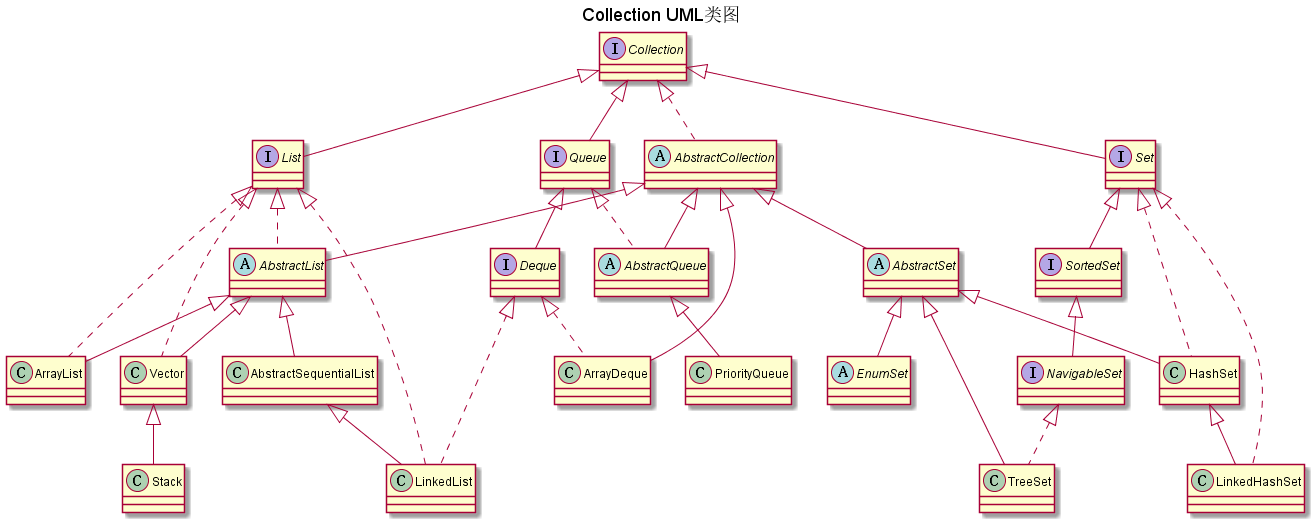Collection接口
1 | public interface Collection<E> extends Iterable<E> {} |
框架:

它是一个接口,是高度抽象出来的集合,它包含了集合的基本操作:添加、删除、清空、遍历(读取)、是否为空、获取大小、是否保护某元素等等。
List接口
1 | public interface List<E> extends Collection<E> |
- 允许重复元素
- 有序的队列,List中的每一个元素都有一个索引
Set接口
1 | public interface Set<E> extends Collection<E> |
- 不允许重复元素
AbstractCollection
1 | public abstract class AbstractCollection<E> implements Collection<E> |
- AbstractCollection是一个抽象类,它实现了Collection中除iterator()和size()之外的函数。
- 要实现一个可变的集合,需要重写add()方法,iterator()需要重写remove方法
1 | default void remove() { |
AbstractList
1 | public abstract class AbstractList<E> extends AbstractCollection<E> implements List<E> |
- AbstractList是一个继承于AbstractCollection,并且实现List接口的抽象类。它实现了List中除size()、get(int location)之外的函数
- 要实现一个可变List, 需要重写set(int, E);实现变长List, 需要重写add(int, E),remove(int)
- 和AbstractCollection相比,AbstractList抽象类中,实现了iterator()接口
subList 子List, 子集合改变, List元素也跟着改变
1
2
3
4
5class SubList<E> extends AbstractList<E> {
private final AbstractList<E> l;
private final int offset;
private int size;
}equal()
直接”==”比较 => 是否List类型 => 遍历List,逐个比对是否一致
- hashCode()
1 | public int hashCode() { |
AbstractSet
1 | public abstract class AbstractSet<E> extends AbstractCollection<E> implements Set<E> |
- AbstractSet是一个继承于AbstractCollection,并且实现Set接口的抽象类
- equal()
直接”==”比较 => 是否Set类型 => 长度一致 => 遍历Set - hashCode() 每个元素的hash和
Iterator
1 | public interface Iterator<E> {} |
- Iterator是一个接口,它是集合的迭代器。集合可以通过Iterator去遍历集合中的元素。
- Iterator提供的API接口,包括:是否存在下一个元素、获取下一个元素、删除当前元素。
- fail-fast机制 ConcurrentModificationException异常
- Iterator 和 Enumeration 的比较:
1 | //Enumeration |
区别:
1. Enumeration 是JDK 1.0添加的接口,使用到它的函数包括Vector、Hashtable等类 ;Iterator 是JDK 1.2才添加的接口,它也是为了HashMap、ArrayList等集合提供遍历接口
2. 函数接口不同,Enumeration不支持删除元素操作
3. Iterator支持**fail-fast**机制,而Enumeration不支持,所以Iterator遍历速度会比Enumeration慢
- Iterator 和 Iterable 比较:
1 | //Iterable 接口 |
区别:
Iterable 表示实现了这个接口的集合对象支持迭代 ,是可迭代的,能使用foreach遍历
Iterator 是迭代器,提供迭代机制的对象,具体如何迭代,都是Iterator接口规范的
- Iterator 迭代出来的元素是原来集合元素的拷贝,指向对象的引用
ListIterator
1 | public interface ListIterator<E> extends Iterator<E> {} |
- 提供向前/向后遍历
1 | // ListIterator的API |
